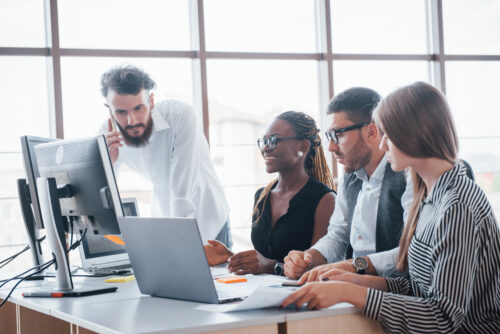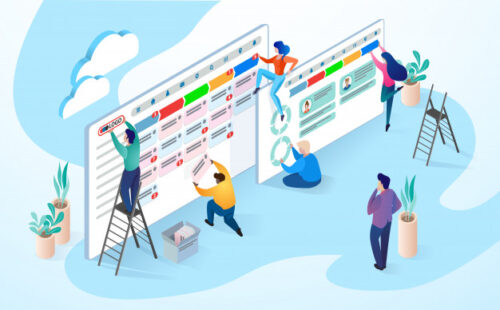Do you have a great idea for a new IT startup but don’t know where to start? Are you worried about how to attract seed investments, outperform competitors and quickly gain user recognition? To be successful, many startup entrepreneurs first release an MVP, a minimum viable product. The most important difference between an MVP and a full-fledged release is its truncated functionality. And although we often want to release software with all planned features at once, developing a product via the MVP stage has its advantages:
- Your business idea will be quickly presented to the audience. For an IT startup, time to market is very important.
- You can test your product concept with end-users on a budget.
- This is a real chance to increase the target audience at an early stage.
- Having a viable product and real users makes you more attractive to angel investors.
So, what are the steps you need to take for your startup?
9 steps leading to success
To achieve a successful IT startup, you’ll need to follow these steps:
Step 1. It all begins with creating the idea for your startup, and most important, defining what will make your future product unique. We’re not just talking about functionality. While there are many internet resources advising on business startup ideas, it’s pretty hard to come up with something super innovative these days unless you have an unlimited budget and plenty of development time. However, new software may compete successfully with others by offering a better user experience, or a more attractive subscription model.
Step 2. Along with defining your idea, it’s vital to specify the target audience. It is no secret that attracting users of different age, income and education requires different approaches.
Step 3. Then you need to conduct market research and compare potential competitors. At this stage, you’re refining the business idea and beginning to figure out how to monetize your future software, as return on investment (ROI) is a very important metric for any startup business.
Step 4. The next step is to attract investment. Because it is difficult to raise funding for startup businesses on bare promises, it makes sense to prepare a clickable prototype that will help present your idea to angel investors. For a relatively small budget, a UI/UX specialist can create an interactive design (for example, in Figma or InvisionApp) that will not only help you present your future product, but also validate the main flow of your software.
Step 5. So, congratulations! You’ve found the seed investment. Now the most important thing is to use it wisely. Software development is not cheap and very often not fast. Meanwhile, investors are waiting for results, and competitors are not asleep. This is where the MVP phase can help. To run your project through MVP, you need to prioritize all the collected requirements and implement high-priority features first. It may help to use the following prioritization technique:
- Must have – a high-priority requirement, usually the top feature that needs to be implemented first;
- Should have – a medium-priority requirement or feature recommended for an MVP;
- Could have – a low-priority requirement, accepted for the MVP only if we have the time and budget;
- Won’t have now – a very low-priority requirement, which we’ll document for future releases but won’t put into the MVP backlog.
Step 6. To move forward, you’ll need to hire a team of professionals. There are two paths here:
- You can choose to develop an MVP with talented freelancers, or you can hire people on your staff. In either case, you take on all the risks and will need to micromanage the team. If software development is a fairly new activity for you, there is a chance that you will waste some of your budget and perhaps not achieve the desired goal.
- The second way is to enter into an agreement with a software development company. In this case, the hired vendor guarantees the quality and timeliness of delivery, shares the risks and ensures the availability of the team.

Step 7. Together with the development team, you will need to detail and estimate time and budget for the higher-priority features. There is an unspoken rule that the MVP should not take more than 2 months of pure development. Everything that is likely to push the deadline or planned budget is simplified or taken out of the scope of the MVP. Integrations play an important role here: if at the initial stage of development you can save time and budget by integrating third-party software, then you should do so. For example, functionality for software that tracks medication intake will be important for a healthcare IT startup to control, while user management/login/signup functionality can be quite standard and transferred to a third-party service that is certified in accordance with HIPAA and GDPR.
Step 8. Next, it’s important to schedule alpha and beta testing with a limited group of end-users. No matter how professional the team is, a real user, for whom the future product is oriented, gives the most valuable feedback. Based on the results of each of the testing stages, additional improvements can be carried out, and this stage should also be included in the project roadmap.
Step 9. When you are close to going into production, you’ll need to launch an advertising campaign and warm up the target audience. It is recommended that the campaign begin at least during the beta testing phase. To launch your campaign at the right time, you’ll need to start preparing for it much earlier — for example, at the alpha testing stage, when the main scope of the MVP has already been implemented and only minor improvements remain.
Here is a ready-made checklist for a startup entrepreneur you may use for your own needs:
But what is the most important step?
The right vendor can offer not only software development services but also help with doing a competitive analysis of similar software and developing your business idea. In addition, companies with relevant experience can immediately predict what technical risks and legal restrictions you may encounter and suggest how to resolve such issues. DigitalMara has over 10 years of custom software development experience. Just write to us and we will offer the best solution for you.


































